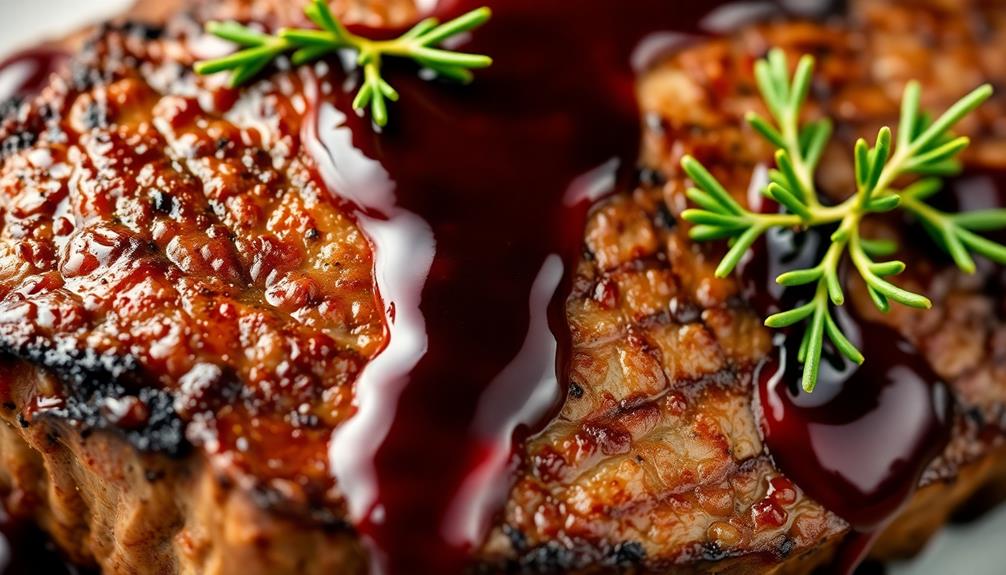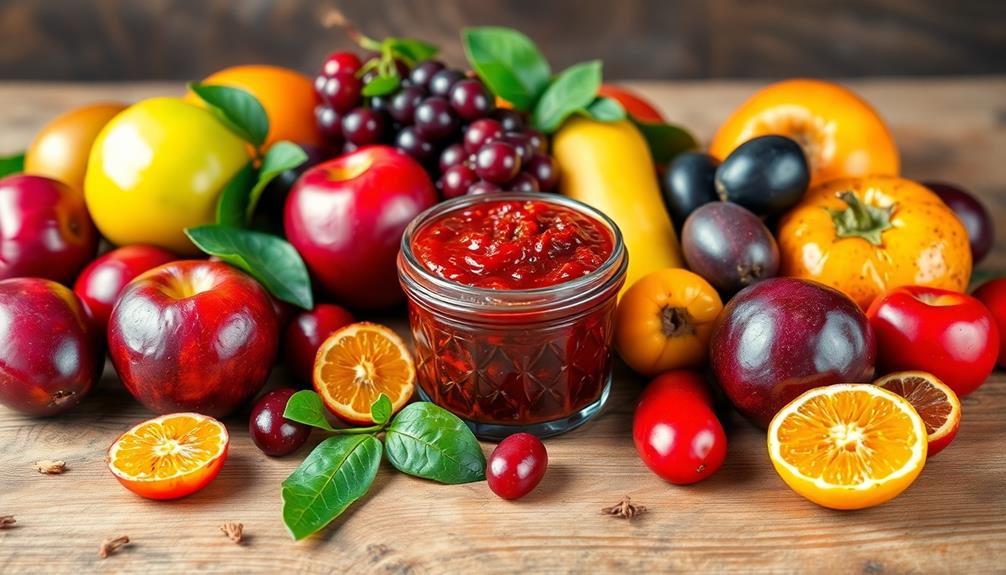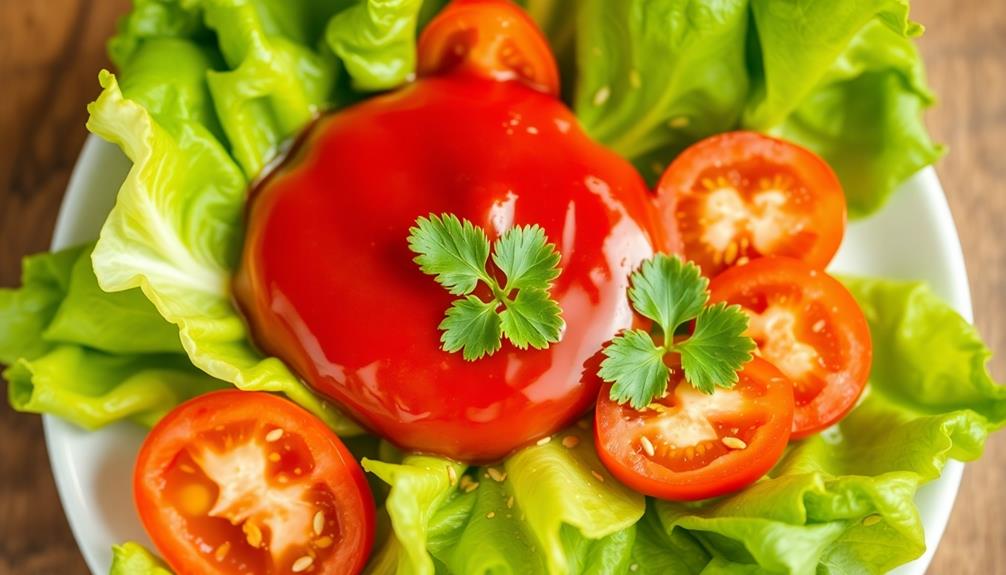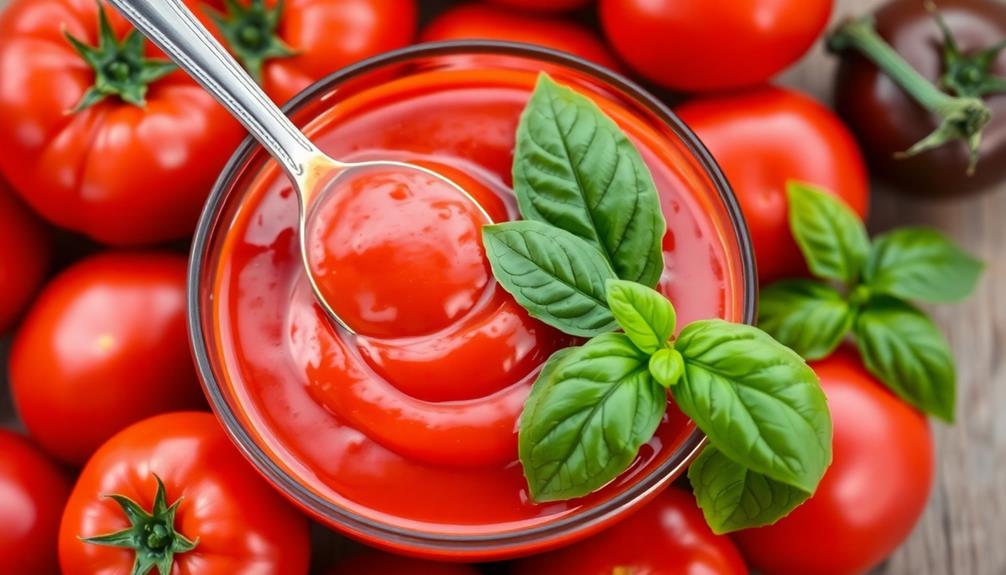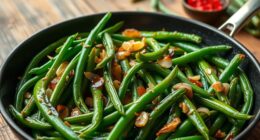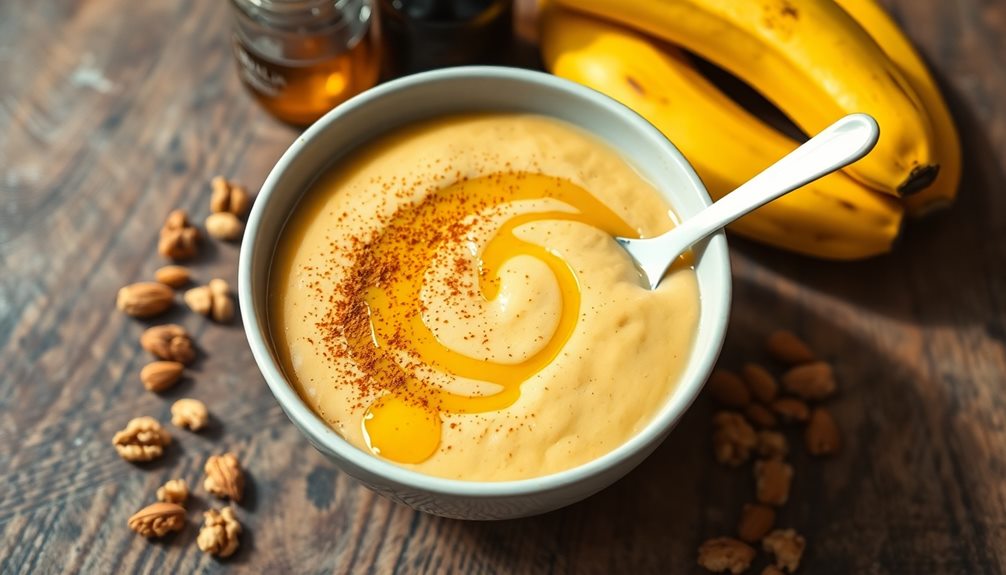Crafting the perfect steak sauce is a delightful culinary journey, unlocking a symphony of flavors tailored to your tastes. Start with a base of sautéed onions and garlic, then simmer in a blend of tomatoes, vinegar, Worcestershire, and spices. Balance sweet, sour, and savory notes to complement your cut of beef – rich sauces for fatty ribeyes, lighter for lean filets. Baste your seared steak with the homemade sauce, allowing the flavors to meld. The depth of flavor you'll achieve will elevate your cooking skills and provide unique experiences – just imagine what other culinary adventures await.
Key Takeaways
- Select a steak sauce that complements the richness and fat content of the beef cut, such as a bold and savory sauce for a ribeye or a lighter, brighter sauce for a filet mignon.
- Prepare a homemade steak sauce that balances the flavors of sweet, sour, and savory to enhance the natural taste of the beef and provide a unique culinary experience.
- Infuse the steak with the steak sauce by basting or allowing the sauce to simmer with the meat, ensuring maximum flavor absorption.
- Experiment with regional or specialty sauces, such as chimichurri for a flank steak, to add a signature touch to the dish.
- Store the homemade steak sauce properly in airtight containers in the refrigerator or freezer to maintain its freshness and flavor profile.
History
The origins of steak sauce can be traced back to the late 18th century, when enterprising cooks began experimenting with various combinations of ingredients to enhance the flavor of beef.
These early steak sauces were often made with simple, readily available ingredients like vinegar, spices, and herbs. As the recipe evolved, cooks started adding more complex flavors, like Worcestershire sauce, anchovies, and even mushrooms.
Over time, steak sauce became a staple in many kitchens and restaurants, with each establishment developing its own unique blend to complement the perfect steak.
Today, you can find a wide variety of steak sauces, from bold and spicy to smooth and savory. Whether you prefer a classic A1 or a homemade creation, the history of steak sauce is a testament to the creativity and ingenuity of cooks who've always strived to make the most of their beef.
Recipe
Steak sauce is a versatile condiment that can elevate the flavor of any grilled or pan-seared steak.
Whether you prefer a tangy, sweet, or savory sauce, the right recipe can turn a simple steak into a culinary masterpiece.
Crafting the perfect steak sauce requires balancing a harmonious blend of ingredients. The key is to find the right combination of flavors that complements the natural taste of the beef without overpowering it.
With a few simple steps, you can create a homemade steak sauce that will have your guests raving.
- Ketchup
- Worcestershire sauce
- Dijon mustard
- Brown sugar
- Garlic, minced
- Onion, finely chopped
- Red wine vinegar
- Soy sauce
- Black pepper
In a saucepan, combine the ketchup, Worcestershire sauce, Dijon mustard, brown sugar, garlic, and onion.
Bring the mixture to a simmer over medium heat, stirring occasionally, until the onions are softened and the flavors have melded, about 10 minutes.
Stir in the red wine vinegar and soy sauce, and season with black pepper to taste.
Adjust the seasoning as needed to achieve your desired balance of sweet, tangy, and savory.
Cooking Steps
Crank up that heat and sear that steak to perfection!
Now, it's time to add the savory sauce. Let it simmer for about 5 minutes, then reduce the heat.
As the sauce thickens, use it to baste the steak, ensuring every bite is bursting with flavor.
Step 1. Sear the Steak at High Heat

After seasoning the steak, it's time to get your cooking surface ripping hot.
You'll want to crank the heat up to high and let that pan or grill grate get nice and toasty. This is the key to getting that perfect sear – that delectable caramelized crust on the outside of your steak.
When the pan or grill is screaming hot, gently lower the steak onto the surface. You'll hear that satisfying sizzle as the meat hits the heat.
Resist the urge to move it around – let it sit and work its magic for 2-3 minutes. This allows the Maillard reaction to do its thing, creating those mouth-watering browned bits.
Flip the steak and let the other side sear for another 2-3 minutes.
You'll know it's ready when you see a nice crust forming. The steak should release easily from the pan or grill when it's time to flip.
Once both sides have that perfect sear, you're well on your way to steak perfection!
Step 2. Add the Sauce
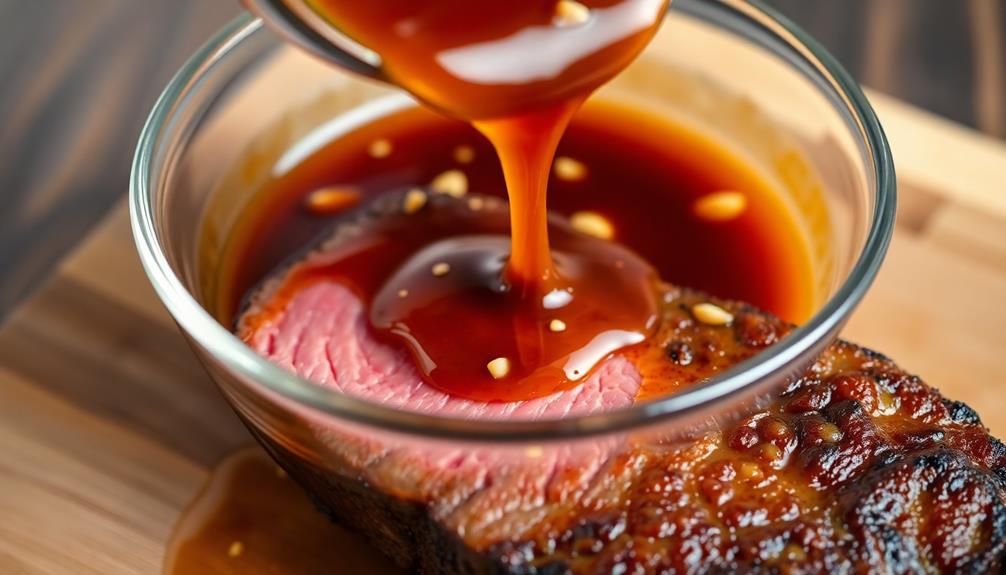
Adding the sauce is the next crucial step in achieving steak perfection.
After searing your steak to perfection, it's time to add the finishing touch – the sauce. This is where you can really make the flavors of your steak shine.
Start by pouring the sauce over the hot steak. You'll want to use a flavorful, high-quality steak sauce that complements the natural beefiness of your cut.
Gently spoon the sauce over the top, making sure to cover the entire surface. As the sauce hits the hot steak, it will begin to sizzle and mingle with the juices, creating a delicious, cohesive flavor.
Let the steak rest for a few minutes, allowing the sauce to fully absorb and infuse the meat.
Step 3. Simmer the Sauce for 5 Minutes
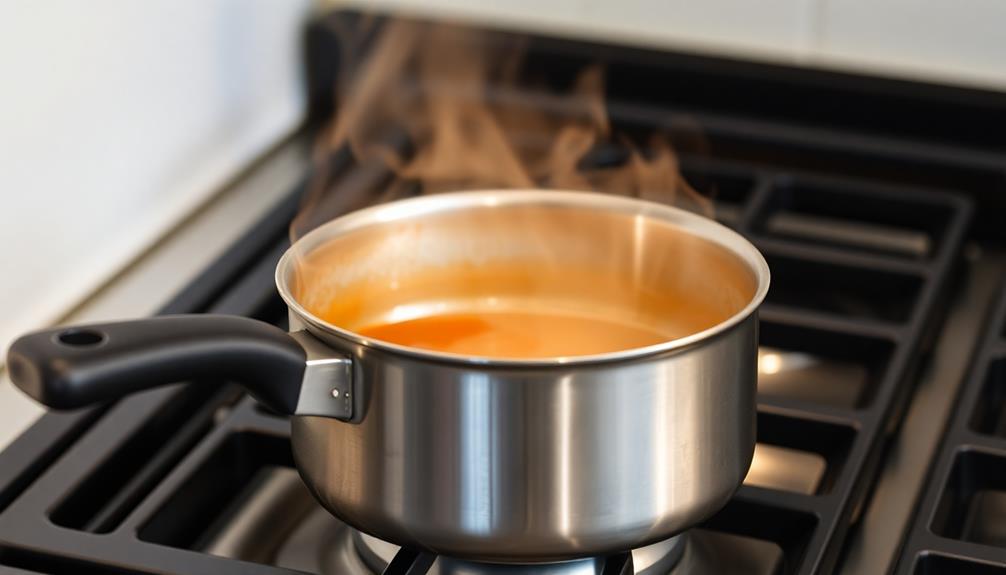
Next, simmer the sauce for about 5 minutes. This step is crucial to blend the flavors and create a delicious, cohesive sauce.
As the sauce simmers, you'll notice the aromas fill the air, making your mouth water in anticipation. The gentle heat allows the ingredients to meld together, with the acidity from the tomatoes and the richness of the beef stock melding seamlessly.
Stir the sauce occasionally to ensure even cooking. You'll see the consistency thickening, becoming more velvety and luxurious. This short simmer time ensures the sauce maintains its bright, vibrant color, rather than becoming dull or murky.
Once the 5 minutes are up, your steak sauce is ready to be drizzled over your perfectly cooked steak, complementing the meat's flavor and texture.
Get ready to experience the perfect balance of sweet, savory, and tangy in every bite.
Step 4. Reduce Heat, Allow Sauce to Thicken
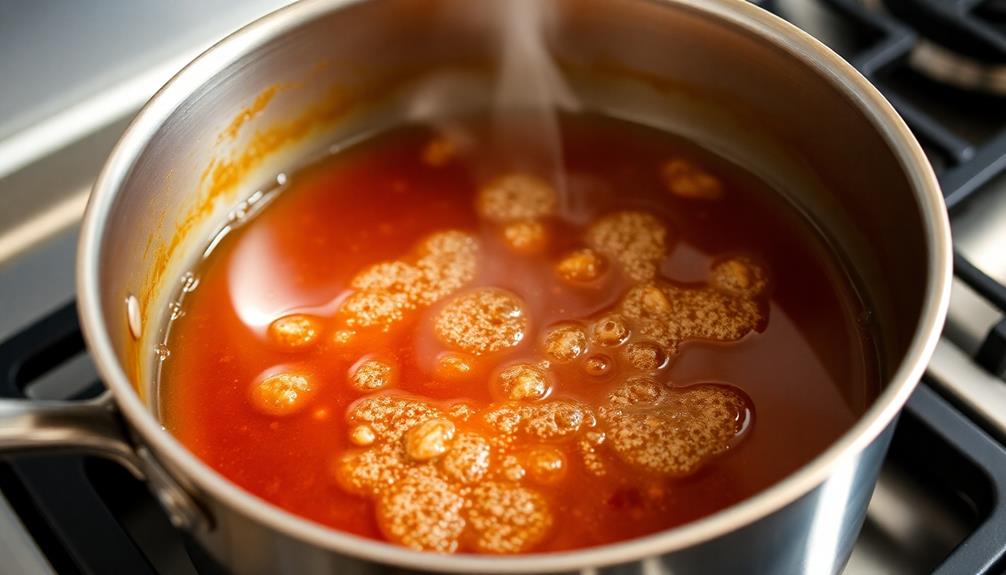
Once the sauce has simmered for 5 minutes, you'll want to reduce the heat to low. This allows the sauce to gently thicken, developing a rich, velvety texture. As the heat lowers, you'll notice the sauce begins to coat the back of your spoon more readily.
Don't worry if it seems a bit thin at first – the magic happens as you let it simmer and slowly reduce.
Keep a close eye on the sauce, stirring occasionally. You'll know it's ready when it has a smooth, glossy appearance and clings nicely to your spoon. This process typically takes 5-10 minutes, but the exact time will depend on your stovetop temperature and the volume of the sauce.
Be patient and resist the urge to crank up the heat – slow and steady is the key to achieving the perfect consistency.
Once the sauce has thickened to your liking, it's time to taste and make any final adjustments. This brings us to the next step: seasoning the sauce to perfection.
Step 5. Baste the Steak With the Sauce
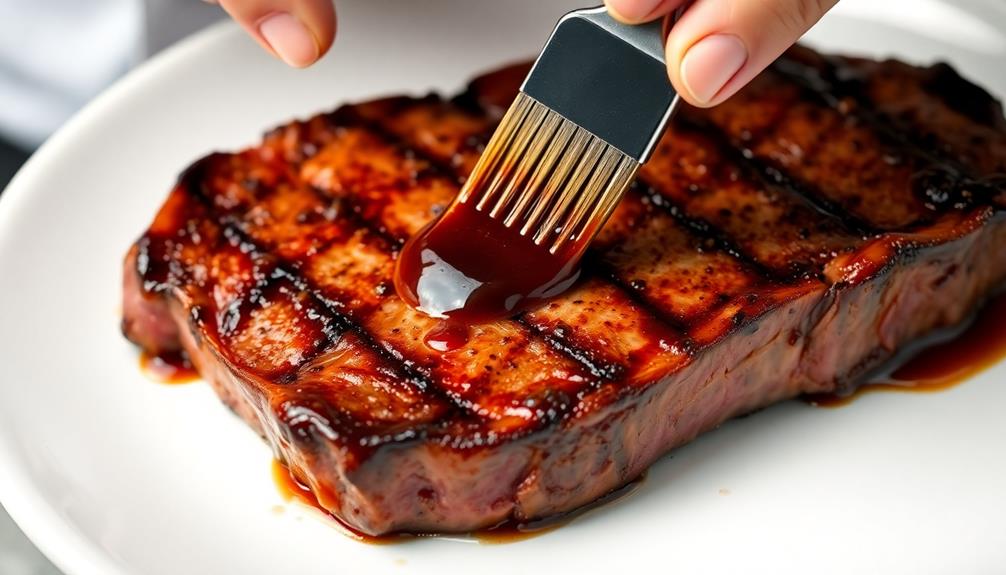
With the sauce perfectly thickened, it's time to put it to use. Take your sizzling steak off the heat and grab a basting brush. Gently brush the sauce all over the surface of the meat, making sure to coat every nook and cranny. The rich, savory flavors will seep into the steak, creating a mouthwatering caramelization that'll have your taste buds dancing.
Don't be shy – give that steak a good coating. You want the sauce to really cling to the meat, so brush it on thick and evenly. As the steak rests, the sauce will continue to infuse it with its delectable essence.
When you slice into that perfectly cooked piece of beef, you'll be rewarded with an explosion of flavor in every bite. Basting the steak is the final step in bringing this sauce to life.
With a little care and attention, you'll have created a dish that's sure to impress. Get ready to savor the fruits of your labor – this steak is about to be better than ever!
Final Thoughts
As you put the finishing touches on your steak sauce creation, a sense of accomplishment and culinary pride likely washes over you. After all, crafting the perfect steak sauce is no easy feat.
But now that you've mastered the balance of flavors, you can confidently serve it alongside your perfectly cooked cut of beef.
The true beauty of a homemade steak sauce lies in its ability to elevate the natural taste of the meat. Each ingredient you've carefully selected and blended together works in harmony, complementing the steak's inherent richness.
Whether you prefer a bold and tangy sauce or one with a touch of sweetness, the options are endless when you make it yourself. You can experiment with different combinations of spices, herbs, and fruits to create your own unique flavors. From spicy chipotle barbecue sauce to sweet and savory chutney recipes, you have the freedom to tailor your homemade sauce to your exact taste preferences. Making your own sauce is not only satisfying, but it also allows you to control the quality and freshness of the ingredients.
As you savor that first bite, you'll be reminded of why taking the time to craft your own sauce is so worthwhile. The depth of flavor and the way it enhances the steak's texture are simply unmatched by store-bought varieties.
Enjoy the fruits of your labor and take pride in this culinary accomplishment.
Frequently Asked Questions
How Long Can the Steak Sauce Be Stored?
You can store the steak sauce for up to a week in the refrigerator. Be sure to keep it in an airtight container, and it'll maintain its fresh flavor and consistency. Enjoy your steak with this tasty sauce!
What Is the Best Way to Reheat the Sauce?
The best way to reheat the sauce is to do so gently over low heat, stirring frequently. This will help preserve the flavors and prevent the sauce from becoming too thick or separated. Avoid microwaving, as it can lead to uneven heating.
Can the Sauce Be Used on Other Types of Meat?
Absolutely! The sauce can be used on other types of meat as well. Its rich, savory flavors complement chicken, pork, and even fish, adding an extra depth of flavor to your dish. Feel free to experiment with it.
Is the Sauce Suitable for Vegetarians or Vegans?
The sauce isn't suitable for vegetarians or vegans since it's made with beef-based ingredients. However, you could try creating a plant-based alternative using mushrooms, herbs, and other savory flavors to complement your vegetarian or vegan dish.
Does the Sauce Contain Any Common Allergens?
The sauce may contain common allergens like dairy, soy, or tree nuts. It's important to carefully review the ingredient list to ensure it aligns with your dietary needs and any food allergies you may have.
